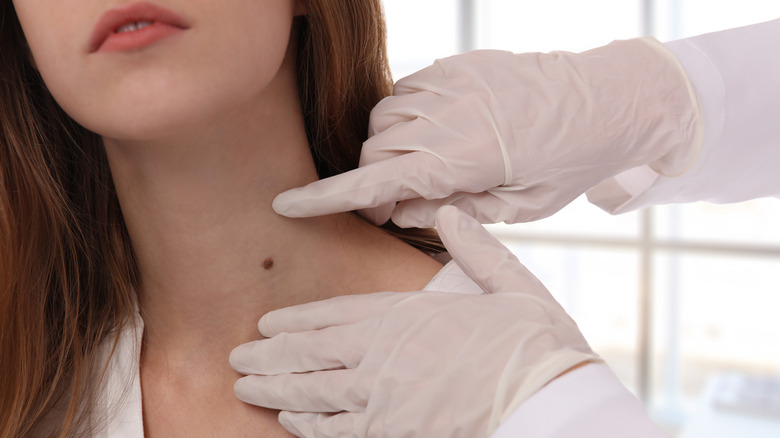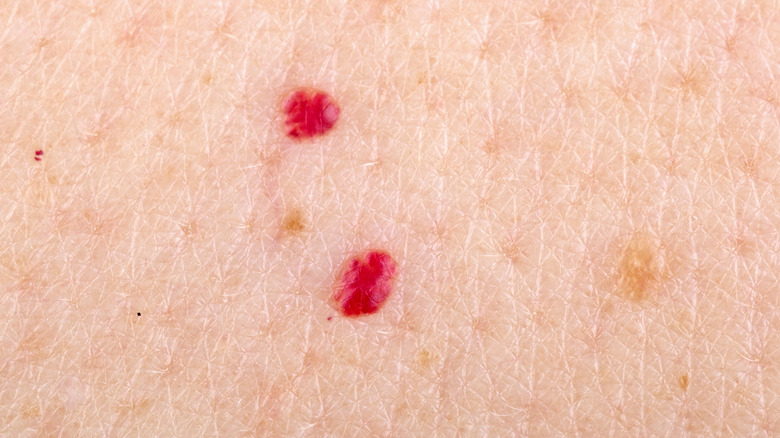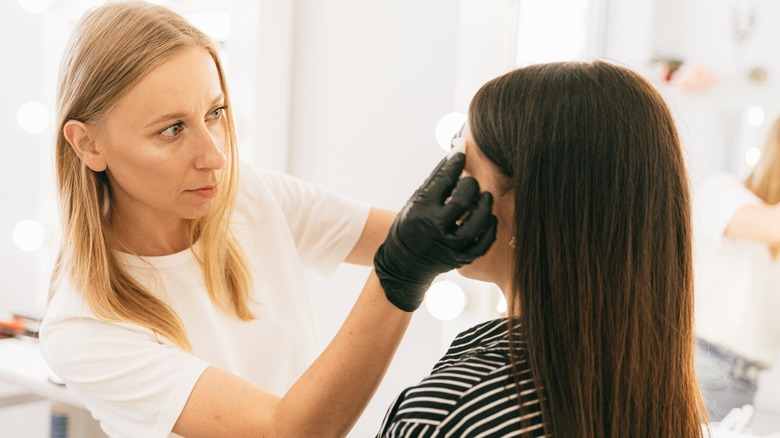The Difference Between Skin Tags And A Cherry Angioma
Both skin tags and cherry angiomas are growths that can appear anywhere on the body, and seemingly grow more common the older we get. Both can be unsightly and alarming, as they suddenly sprout up all over your body. As new moles appear on the skin, a person's first reaction might be panic, stemming from the fear of cancer. However, in many cases, that is not a concern. The good news is that both skin tags and cherry angiomas are almost always benign, and tend to be more of a cosmetic nuisance as opposed to an actual health risk (via the Cleveland Clinic).
Knowing that our skin can be prone to these different growths, it's essential to understand what it is we're dealing with whenever one pops up. Both skin tags and cherry angiomas look different and present in different ways (via Magnolia Medical and Aesthetics). Therefore, knowing what you're up against when faced with skin conditions will help you be prepared when the time comes to receive treatment.
What exactly are skin tags and cherry angiomas?
Also known as acrochordons, soft fibromas, or fibroepithelial polyps, skin tags are small, benign growths that have the appearance of a raised mole. They are connected to the surface of the skin by a narrow stalk (via the Mayo Clinic). They tend to be the color of your skin, although they can occasionally be darker as well.
Skin tags can appear anywhere on the body, but they are most prominent in areas where natural skin folds are formed and movement causes the skin to rub together. These include armpits, eyelids, under the breasts, and the genitals. There is no one cause, although a family history of skin tags, or health issues, like diabetes or obesity, can be factors (via the Cleveland Clinic).
Cherry angiomas are small, red and round lesions, ranging in size from about 2 to 4 millimeters in size (via the Cleveland Clinic). The appearance of cherry angiomas can differ, as some can be raised while others are smooth and flat. Their red color is caused by the collection of blood vessels that form inside an angioma (via Healthline).
According to Healthline, their exact cause is unknown, but there could be a genetic factor that makes you more inclined to form them. The Cleveland Clinic reports that cherry angiomas are very common among adults, with approximately 50% of adults developing them after age 30. Once people reach 75 years or older, that number can jump as high as 75%.
How are these skin conditions treated?
Generally, skin tags don't require treatment, as they tend to be both painless and harmless. If you're not bothered by them, and if they aren't in a conspicuous place on your body, you can opt to leave them alone. In some cases, they may fall off on their own (via the Cleveland Clinic).
If you do decide that you want to remove any of the skin tags on your body, your best bet is to consult with a dermatologist. Your doctor has a number of options that he or she can decide to employ, including surgical scissors, freezing with liquid nitrogen, or cauterization (via the Mayo Clinic). These procedures can carry with them a small amount of risk, as the site can bleed or become infected, or leave behind a slight discoloration.
Cherry angiomas often don't need to be treated, either, unless they are bleeding or negatively impacting your appearance (via Mount Sinai). They can be removed via cauterization or freezing, or your doctor may opt to use a laser or small blade in a procedure called a shave excision.
If your skin tags become inflamed or painful, contact your healthcare professional — don't try to remove them on your own (via the Cleveland Clinic). According to Healthline, with cherry angiomas, if you notice any changes in the way it looks, it's wise to schedule a doctor's appointment and let them determine the best course of action.



